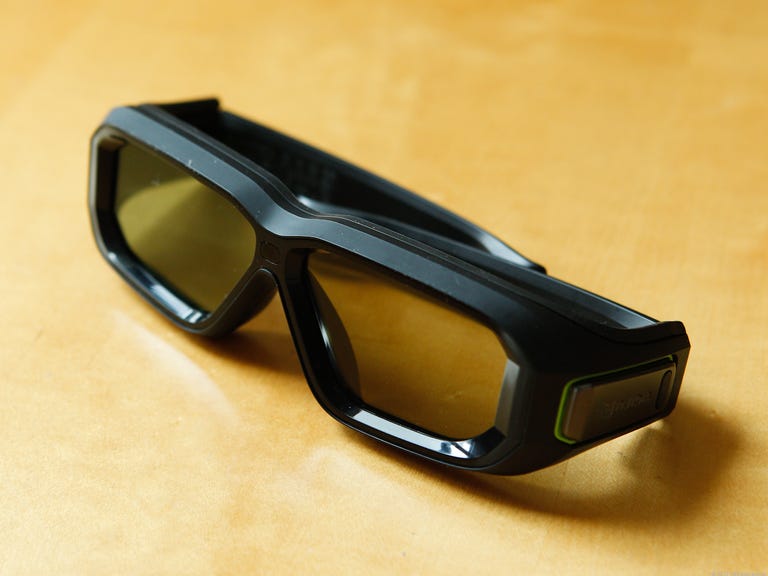 Why You Can Trust CNET
Why You Can Trust CNET Nvidia 3D Vision 2 Wireless Glasses (Extra Pair) review: Nvidia 3D Vision 2 Wireless Glasses (Extra Pair)
The Nvidia 3D Vision 2 glasses sport a new design and if you own a Light Boost compatible monitor, deliver excellent performance.
A few years back, Nvidia released its 3D Vision Kit active 3D solution. At the time, it was the only real choice for 3D PC gaming, but its crushingly dark images and abundant crosstalk were problems. The Nvidia 3D Vision 2, along with Lightboost technology, attempts to address those issues.
The Good
The Bad
The Bottom Line
Design and features
The Nvidia 3D Vision 2 glasses look less like actual glasses and more like goggles. This can be attributed to the thick brim and endpiece that surround the lenses, as well as the more angular edges compared with the first-gen 3D Vision glasses. In fact, the second-gen glasses sport an almost complete redesign from the first-generation specs. Gone is the glossy, piano-black finish, replaced with a matte, dark gray look that thankfully uses a much more comfortable, softer-feeling plastic.
Also, the handles don't squeeze my head as tightly, but still feel suitably snug when wearing the glasses. The nose pad seems to be slightly wider, with the rubber padding covering more surface area. The first-gen glasses sported a thinner, circular-shaped temple that became really uncomfortable when wearing headphones. On the second-gen glasses, the temple is wider and flatter, with a rubber cushion at the ends, making for a much more comfortable experience.
The power button is now located on on the left endpiece, right in the middle of the gray Nvidia logo. The endpiece is also about twice as long as it was before and the Micro-USB port is still located on the underside of the endpiece.
On my model, the right side of the bar wouldn't stay connected and I had to constantly reconnect it. Very annoying, but a minor quibble.
The 3D Vision 2 glasses are just as heavy as the first-gen model, but thanks to some smart design choices, they feel more comfortable when worn and like any good pair of glasses, you can easily forget they're on your face after a while.
Games performance
I used the Asus VG278H to test the 3D Vision 2 glasses' 3D performance and the Samsung SyncMaster S23A750D as a comparison, using Sasmung's active-3D solution. I set each monitor to 200 candelas per square meter (cd/m2) and used Dragon Age 2 as the chief test game. Initially, the 3D depth on each monitor was adjusted to 50 percent.
Right away I noticed how much brighter images on the Asus' screen were compared with the Samsung, a fact that can be attributed to Nvidia's Lightboost technology. The technology is compatible with both first- and second-gen glasses, but requires a monitor that features Lightboost.
Lightboost controls both the backlight of the display and shutter behavior on the glasses. With non-Lightboost monitors, shutter behavior is less efficient, exemplified by times when each shutter would be closed at the same time during operation. Also, the content being shown on the monitor displays each frame, sequentially, with no pause in between. These characteristics of non-Lightboost tech cause images to both appear dark as well as display noticeable crosstalk.
With Lightboost, the shutters on each lens alternate more precisely and both are never closed at the same time. Also, in between each frame of the content being shown, the monitor backlight shuts off. These two changes, in conjunction with each other, allows for brighter images with less crosstalk.
However, the proof is in the pudding. With Dragon Age 2, crosstalk was difficult to notice most of the time, but it did rear its head when viewing dark images on light backgrounds. Comparatively, the Samsung displayed much more crosstalk, with consistent and apparent ghosting on the edges of character models. Also, when looking at 3D images on the Samsung, my eyes got fatigued much more quickly. Through the Nvidia lenses there was also a much more dramatic and convincing 3D parallax effect when I viewed the display from different angles.
3D works when it can successfully trick your brain into believing two images are actually one and is usually most successful with polygonal images; however, 2D images that aren't in the actual game environment, like cursors, are usually less convincing. Not surprisingly, viewing the cursor as one image was problematic, causing my eyes to strain and adjust to the new image.
After lowering both monitor's 3D depth down to 25 percent, hardly any ghosting was noticeable on the Nvidia, but I continued seeing double on the Samsung.
I also tested Crysis 2 and Black Ops, and both delivered similar results.
Movies
Using the Nvidia solution, the "Three Musketeers" 3D Blu-ray looks bright and sharp and with the 3D depth level set at one, showed virtually no crosstalk. With the depth increased to four, fast moving images are a lot blurrier and I felt more strain on my eyes.
Running the same movie, images on the Samsung were darker, blurrier, and more stressful (on my eyes) to watch.
Conclusion
In order to take advantage of Lightboost, you’ll need a compatible monitor. The Asus VG278H comes with the 3D glasses, as well as a built-in emitter, and is available for about $650. There's a more expensive Acer model as well as a BenQ that’s actually really hard to find in the states from major retailers.
If you already have the first-gen Vision Kit, these glasses will only make a difference in comfort and their ability to block out ambient light -- advantages that may not be worth the extra $85.
3D Vision 2 with LightBoost is the best 3D solution for 3D games. Now we just need to see more monitors made that take advantage of the technology.


